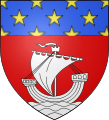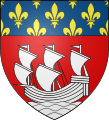Coat of arms of Paris
| Coat of arms of Paris | |
|---|---|
 | |
| Versions | |
|
Escutcheon-only | |
| Details | |
| Armiger | City of Paris |
| Adopted | 1358 |
| Escutcheon | Gules, on waves of the sea in base a ship in full sail Argent, a chief Azure semé-de-lys Or |
| Motto | Fluctuat nec mergitur (She is tossed by the waves, but does not sink) |
| Orders |
Legion of Honor Ordre de la Libération Croix de Guerre |
| Other elements | Above the shield a mural crown Or |
The coat of arms of the city of Paris, in its current form, dates back to 1358. On the coat of arms, the represented vessel is the symbol of the powerful corporate body of the Marchands de l'eau, dating back to the Middle Ages. The city motto, "Fluctuat nec mergitur" ("She is tossed by the waves, but does not sink") is equally a reference to this boat.
Design
In its full representation, it also includes decorations that the city was authorized to include:
- The Legion of Honor (Decree of 9 October 1900);
- The Ordre de la Libération (Decree of 24 March 1945); and
- The Croix de Guerre 1914-1918 (Decree of 28 July 1919).[1]
History
The first mention of coat of arms of Paris appears as early as 1190 when Philippe Augustus gave the design to the city, shortly before embarking to the Holy Land. When the French Revolution abolished the nobility by the decree of 20 June 1790, it simultaneously disallowed all emblems or coats of arms. The municipality of Paris quickly complied, and abolished its own arms in November of that same year. It was not until the First French Empire that new cities were officially allowed to have arms. For Paris, this resulted in the Letters Patent granted to the city of Paris by Napoleon on 29 January 1811. In the Letters Patent of Louis XVIII in 1817, the coat of arms of Paris was restored in its traditional form.[2] The motto "Fluctuat nec mergitur" first appeared from the end of the sixteenth century, but it was made official by a decree of Baron Haussmann, then prefect of the Seine, dated 24 November 1853.
 Escutcheon of Paris under the First Empire
Escutcheon of Paris under the First Empire.svg.png) Armorial of Paris under the First Empire
Armorial of Paris under the First Empire Escutcheon of Paris under the Second Republic
Escutcheon of Paris under the Second Republic Escutcheon of Paris under the Second Empire
Escutcheon of Paris under the Second Empire Present, lesser version of the arms
Present, lesser version of the arms
Modern usage

The coat of arms is to be found on many Parisian public buildings, including the Hôtel de Ville, the mairies of the 20 arrondissements, the train stations, the bridges, and primary and secondary schools, and la Sorbonne . Today, the police headquarters of Paris uses a logo inspired by the coat of arms of the city of Paris. It was also represented on a postage stamp issued in 1965, the 0.30 franc "Blason de Paris". It's also used as the Garde républicaine's insignia.
City colors
The traditional colors of the city of Paris are red and blue. Their official usage dates back to the year 1358, when Étienne Marcel first made use of them.[3] The French tricolor flag is derived from the combined cockade of the king (white) and the Paris Commune (red and blue).
References
- ↑ Thierry, Halay (1998). Paris et ses quartiers. L'Harmattan. p. 8. ISBN 2-7384-6691-5.
- ↑ Hillairet, Jacques (1985). Dictionnaire historique des rues de Paris. éditions de Minuit. p. 46. ISBN 2-7073-1054-9.
- ↑ Faure, Juliet (2002). L'arsenal de Paris: histoire et chroniques (in French). L'Harmattan. p. 35.
- Josette Eugénie Spink, Le beau pays de France, Ginn and Company, 1922.
- M. de Saint-Allais, L'art de vérifier les dates des faits historiques..., C-F Patris, 1818.
- François Rittiez, L'Hôtel de ville et la bourgeoisie de Paris: origines, moeurs, coutumes, institutions municipales depuis les temps les plus reculés jusqu'à 1789, Schlesinger Frères, 1863.
- Philippe Lefrançois, Paris à travers les siecles, Calmann-Lévy, 1948.
- Logo des Jeux olympiques de 1924.
- Juliette Faure, L'arsenal de Paris: histoire et chroniques, L'Harmattan, 2002 (ISBN 2747516164).
- Marc Declerck, Les armoiries de Paris, L'Harmattan, 2007 (ISBN 2296025471)
External links
![]() Media related to Coats of arms of Paris at Wikimedia Commons
Media related to Coats of arms of Paris at Wikimedia Commons
